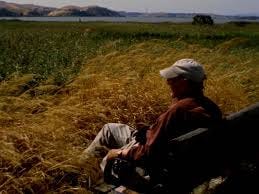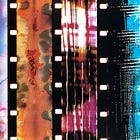Discovering the films of Nathaniel Dorsky and Jerome Hiler was my filmgoing highlight of 2024. I jotted down lots of frantic notes on their films for the site, which I’ll link below, but in short, what both Dorsky and Hiler get at better than almost any other living filmmaker is creating an intensely private, lyrical cinema. Crafting images that exist on the edge of abstraction, both filmmakers, through wildly disparate formal techniques, reveal the mysteries of the cosmos within the everyday. Of the two, Hiler’s films tend to feel more extroverted, often featuring multiple exposures moving in opposing directions, creating a rushing, stained-glass collage of experience. Shot in self-contained movements, each ending with a fade to black, they play to me as present-tense memory musicals.
Per Hiler’s notes on Canyon Cinema, his latest film, Careless Passage, is intended to “muse and swim among migrant sights seen by the transforming eye of a camera”. The adjectives muse and swim feel apt here, as Careless Passage plays to me as one of Hiler’s most autumnal films, explicitly reckoning with the final stage of one’s life. Its pacing is more leisurely than say, the flying sparks that open Words of Mercury, and its movement in general is more circular than lateral.
If there’s a through-line between Careless Passage’s dominant multi-exposure “movements”, it’s that each superimposition takes place in or around domestic space. Prominently featured within the film are lampshades, windows, concrete slabs, and gateways. In some ways, the focus on interiors marks Careless Passage as a loose successor to the diptych of In the Stone House and New Shores, with this latest film more obliquely commemorating a new phase of Dorsky and Hiler’s romantic and artistic partnership. The more abstracted qualities of the images in Passage speak not just to Hiler’s formal evolution in the intervening half-century but also an accumulation of life experience. In the centerpiece sequence, Hiler turns household objects into elements within a molten, subterranean netherworld, overlaying lamps and glistening bubbles over a lattice of square floor tiles before pink bubbling water and shifting gray walls flood the screen. Bubbles are one of the film’s recurring images, and multiple sequences simply observe bubbles twinkling atop a dark surface. Their glimmering, crystalline membranes act as a perfect metaphor for the humble divinity of Hiler’s cinema.
Between these more abstracted sequences, Hiler includes more recognizable diaristic images, each trembling with a bittersweet intimacy. In many of them, Hiler finds elegiac natural superimpositions, such as the interlocking grids of chain link fences, gleaming light reflecting off of the spokes of a ferris wheel, or shadows gliding over concrete. In one particularly striking shot, Hiler captures a group of schoolchildren walking through the park. The saturated colors, adjusted frame rate and the dense shadows feel texturally Dorsky-esque, and there’s something quite moving in how the shot sits between intentional homage and the inevitable influence of shared life.
In two instances, Dorsky actually appears onscreen. In the first, Hiler lovingly gazes at Dorsky sitting on a bench, framed by golden wheat. Later, in an tenebrous, underexposed shot, we see Dorsky walking among a grove of trees. As he wanders, the obscured image cuts to a tide of red flowers, almost as if Hiler is trying to memorialize his life partner’s inner world. In Dorsky’s fading figure is a loving recognition of mortality, and the relative darkness of Careless Passage’s retroactively plays as a gentle confrontation with the inevitable. The final shot returns to bubbles, each orb gleaming with a kaleidoscopic purple and orange heart. In their form is life’s delicate transience.











